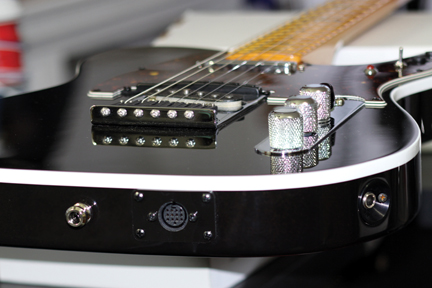

While it adds some more bulk, it's relatively tiny.

Maybe I will give it a try.)īeing an additional kind-of-pickup (which can be simply clenched between the guitar's strings and its body, next to the bridge), the TPC (like MG2) also translates the acoustic signal of the guitar into MIDI, but it is much more accurate, as it has a single little pickup for each string (and doesn't have to "guess" as much as MG2).

It would still be interesting to compare it to MG2 though.
MIDI GUITAR SOFTWARE
(Side note: there is a similar software called MiGiC, but it is only available for desktop computers. Price: 30-40$ (depending on the In-App-Purchases, I'm not 100% sure which ones will be needed) On the other side, it has some nice presets and FX (but I doubt I can assign any MIDI bindings to them so I could switch between them using my iRig BlueBoard foot controller) (UPDATE: MG2 does allow to assign midi CC to select settings).
MIDI GUITAR MANUAL
And it is a bit cumbersome to route its MIDI to an AUv3 synth in AUM: as MG2 itself cannot be loaded as an AUv3 input, I would need to have the app running in the background, which adds more manual complexity (and more sources for problems) to my already complex setup around AUM and GTL. But it is not too accurate with an acoustic guitar (compared to an electric one). It translates the acoustic signal of the guitar into MIDI. I'm pretty close to getting one of them, but I'm still a bit unsure which will be suited best for me.īeing an iOS app, this would be the easiest solution. I'd love to hear your opinions about the pros/cons of those solutions. So I started evaluating "guitar to MIDI" solutions. I was thinking of attaching my nanoKEY2 to my guitar's body, but that is too bulky. I'd love to be able to also play some synths through MIDI. Using AUM, I process the guitar through Tonebridge (to add some nice FX), and route the guitar and/or mic to Group the Loop (GTL, for live looping). Hopefully the Evo can deliver on the original Jammy’s promise of a guitar that powers a symphony of virtual instruments.For my little one-man-show I have an acoustic guitar and a microphone, both connected to my iPhone SE. It was also a good move on Jammy’s part to reduce the price by a few hundred dollars compared to last year’s model. The company has already raised $85,000 on Kickstarter - well above its $50,000 goal - so it does seem like musicians are interested in what the Evo has to offer. Polyphonic tracking - which has proven difficult to perfect across manufacturers - should also be improved, and will help translate guitar chords into, say, piano chords. It has improved optical sensors too, so it can better handle your picking and strumming while reducing latency. The Evo also has an accelerometer - you can tilt it Guitar Hero-style to modulate certain parameters such as the cutoff frequency. There are more buttons on the body of the instrument, which should provide some performance methods outside of typical guitar playing, and Jammy says that you should be able to even track drums using the controller. In other words, it’s not a MIDI controller crammed into a guitar. The Jammy Evo rethinks the original’s formula, and was designed as a MIDI controller first and foremost.


 0 kommentar(er)
0 kommentar(er)
